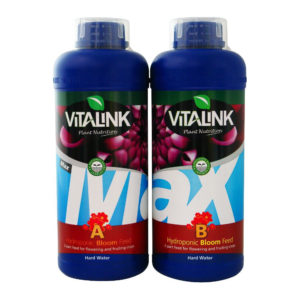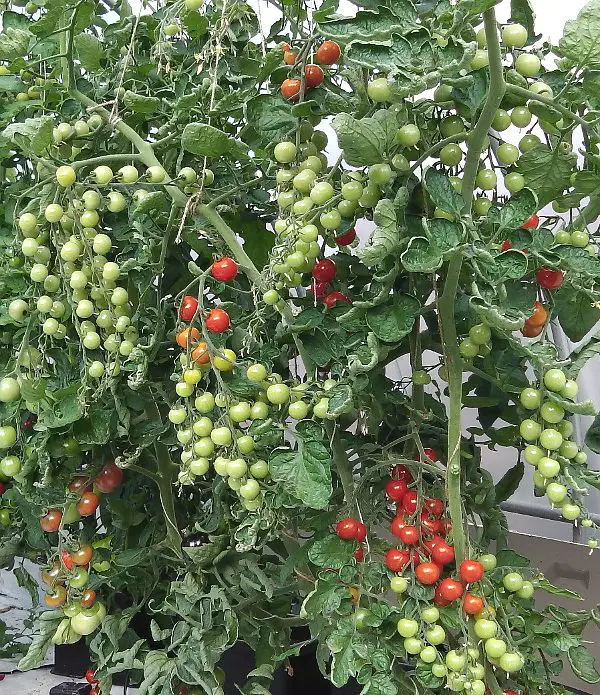I remember some seasons ago commenting on the subject of calcium and tomatoes, and the lack of calcium in liquid tomato food.
What I didn’t know at the time was that calcium precipitates (won’t mix) when added as a liquid with (some) other mineral nutrients. The calcium drops out of the solution and solidifies, often creating a white film over the bottom of watering cans and containers.

Two part feeds
To avoid the problem, undiluted liquid nutrients are often kept in two separate containers A and B as in the case of the Quadgrow Planter.
When you buy a Quadgrow Planter, they provide two containers with a powder in each to add your own water.
One is the main nutrient formula and the other is calcium. These are added separately to the watering can or water tank. Because the strength of the minerals have been diluted, precipitation doesn’t occur – hopefully!
You may wonder why this is relevant?
Well, most liquid type feeds such as Tomorite do not contain calcium – you will need to make sure that whatever medium you are using has calcium in it.
Compost and Limestone
Most good quality potting compost will contain enough calcium in the form of ground limestone, which is used to raise the pH of compost, to offset the low pH of peat – and end up with a pH somewhere between 6.0 and 7.0. The best soil pH for tomatoes is around 6.8.
Tap water
Calcium also raises the pH of water – hence hard water areas where kettles rattle because of a calcium deposit.
The importance of calcium
Calcium isn’t just important in order to avoid Blossom End Rot, it is used in cell wall formation and is required in many aspects of growth.
Because it is immobile (doesn’t move around a plant’s system as nitrogen does for example), deficiency symptoms show first in new growth. Young leaves can lose their colour and plants become stunted, stiff and woody.
Important tip … If buying peat free compost next season, be aware that limestone, which is normally added to compost that contains peat, to counteract the low pH of peat (see above), may not have been added. It is always worth adding calcium as a foliar spray through the season – just in case!

Soil, Compost and Peat
There is often a misunderstanding when it comes to compost, peat and soil in its true sense.
- Compost is not true soil
- Peat is not true soil
- Clay, sand and silt is true soil – also called loam soil
Compost usually contains decomposed green and organic material plus peat, lime and nutrients. Peat is decomposed matter too.
True soil contains clay, sand, silt and humus plus a few extras and is usually called “loam soil” or mineral based soil.
What is Humus?
Humus is made by the action of soil organisms – worms for example – from organic matter.
Humus and Clay – The Bees Knees and The Real Thing!
Humus particles attach themselves to clay particles and become a storehouse for nutrients as well as holding good amounts of moisture. John Innes is a real soil mix and contains humus and clay, as opposed to a soilless mix which is normally how you might describe potting compost that is largely composed of peat without humus and clay.
We often see bags of compost “with added John Innes” on the front.
This provides the benefit of both organic composted material with humus and clay, which in the right amounts, will provide the best of both mixes.
Why is humus/clay so important for plants – especially hungry and thirsty tomato plants?
There is a term called “cation exchange capacity” – a term that could make anyone run for the hills!
It is simply an exchange of nutrients – roots exchange the hydrogen ions in their roots for other nutrient ions held in soil particles. That’s how roots are able to absorb calcium, magnesium and potassium for example.
The fact is, real soil – loam, containing humus and clay – can hold more nutrients and moisture than basic potting compost.
The benefits of this ability, to store nutrients and moisture better than ordinary potting compost, is that plants are less likely to suffer from blossom end rot and fruit split, to name just two problems, if grown in loam soil.
Humus and wormeries
Worm humus is one of the best additions we can add to any mix and the reason why wormeries are becoming so popular. Worm humus added to a clay based mix, like John Innes, will be more effective than when added to a soilless mix because of the cation exchange capacity of humus/clay particles.
The end in sight already!
I can’t believe the season is in its final stages – during the spring and early summer we could have thrown a seed out of the kitchen window and be picking tomatoes in July. The past few weeks have been a bit more challenging, but if you are growing tomatoes in the UK, you are used to a challenge!
Regards,
Nick
This article “Calcium and Tomatoes” is taken from one of Nick’s Newsletters.


john ferrier
Hi Nick,
A friend down the road has given me some,Tomatillo’s, I am into Mexican food and use my green tomatoes at the end of the season to make a green tomato sauce. I will keep some seeds back if you are interested and will forward them on to you when they are dry. I looked them up on the internet and there is quite a few recipes.
All the best,
Johnf.
Rob
Hi Nick and thank you for another fascinating newsletter. One of my favourite greenhouse tomatoes is Floridity, which does seem especially prone to Blossom End Rot. I like to think I have reduced the incidence of BER by adding a pinch of dried milk powder to the watering can before filling with water and adding Tomarite.
In future, I plan to feed with Chempak which (unlike Tomarite) contains Calcium. This is just one of many pieces of priceless information I have gleaned from your website and intend to put into practice next year. Many, many thanks.
Rob
Nick
Hi Rob,
I’m pleased that you have found the newsletter tips helpful.
I think that Chempak Standard Tomato Food is one of the best tomato feeds on the market and as you suggest, contains calcium which doesn’t precipitate because it comes as a dry powder – with water to be added.
Cheers,
Nick
terry
Hi Nick, Thank you for your Tomato News Letter, Well this year I grew Sungold in the Greenhouse and I must say I was very disappointed with the result, they were very tiny and many so small that they were not a lot of use, but the taste of them was very good, ( will not be growing them again).
Next season I shall revert to my usual growing of Gardeners Delight and Alicante of which I usualy get a very good crop with no BER and very little splitting,
Many thanks from terry
Nick
Hi Terry,
Gardener’s Delight and Alicante are very reliable with an excellent taste as you know.
When fruit are smaller than expected, it is usually because of growing conditions – temperatures, too many flowers or introducing a high potassium feed too soon are just three reasons why tomatoes can be smaller than usual.
Cheers,
Nick
David
Hi Nick,
As usual your newsletter is full of interest! I just want to make a few comments on BER. This year I have only been growing two varieties of tomatoes, ‘Sunstream’ & ‘Gardener’s Delight’. The first is a small plum shaped tomato. I’ve found that while a very vigorous plant it suffers from BER as I’ve found one or two on most of the ripening trusses, especially the first to form. Yet on the 2nd I can’t remember having found even one fruit with BER!
These plants are growing in two beds on my allotment which are side by side & received the same preparation back in the spring, namely lots of well rotted horse manure being dug in & used as a mulch as well.
I also have some plants of ‘Gardener’s Delight’ growing on my balcony at home. None of the trusses of fruit have shown any sign of BER. There plants are growing in compost obviously as garden soil can’t be used in pots. They are growing well albeit a little more spindly than the plants on the allotment. The first fruits are now ripening – a couple of weeks behind the ones on my plot.
Now I wish I’d brought home a few plants of ‘Sunstream’ then I’d have been able to compare the results of the two varieties, those grown in soil on the allotment with those grown in compost on the balcony.
Tomorrow I’ll be writing a blog entry on my tomatoes this year & posting it on my website later in the day. There I’ll be including photos of these toms as it something I can’t do here.
Shame we are at the end of the season & that Blight has reared its ugly head & is killing on my plants on the allotment. I reckon I have no more than a week to ten days to harvest what I can before they are irretrievably lost.
Nick
Hi David,
It often happens that the first truss is more susceptible to BER than trusses that arrive later, owing to better weather conditions and roots are more established.
This wet weather at this time of the season is perfect for blight and very hard to combat if growing outside.
Cheers,
Nick
Buster
In the West Midlands last weeks colder weather with rain, even hail one day, caused radial splitting on the more exposed outdoor tomatoes. Others of the same variety more protected were ok.
A fantastic year for my toms but most plants are now looking worn out. It’s serious leaf cutback time now & I’m picking the ones on their way for ripening in the greenhouse.
Thanks again for the site.
Nick
Hi Buster,
It’s very difficult to avoid radial splitting when it rains and temperatures are up and down as I’m sure you know. I’ve got some toms even in the polytunnel that are suffering with the same problem.
Good idea about cutting back worn out leaves etc. – should help to improve air flow around plants growing close together.
Cheers,
Nick
Gerry Checketts
Hi Nick
Thanks for a most interesting pack of newsletters, the wife and I have not had a garden for over 40 years as we have always lived in flats. We have recently moved into bungalow with the addition of 2 greenhouses and we decided to try and grow tomatoes, thanks to your Info we have been reasonably successful .Our biggest problem has been the watering routine ,next season we are going for a self watering system to help
overcome this. The problem is everyone seems to have bumper crops this season (Tomatoes for Sale)